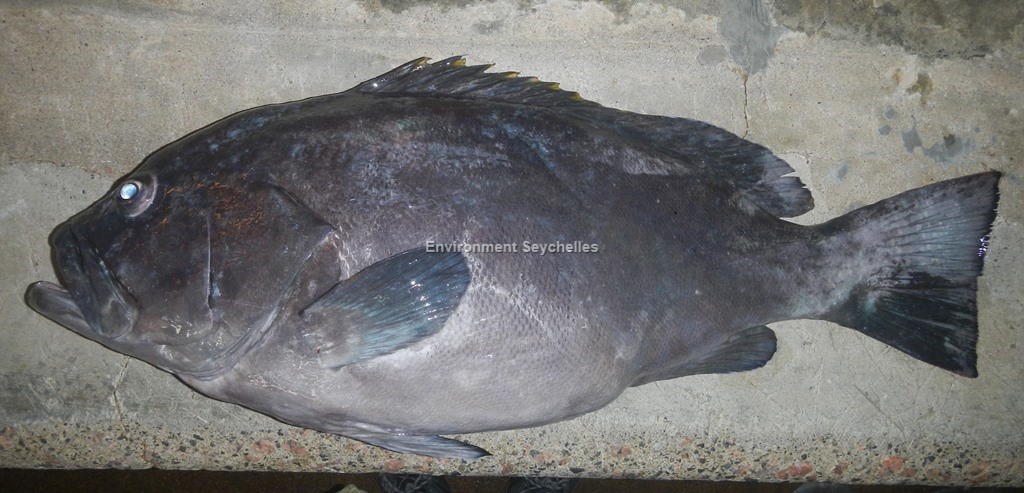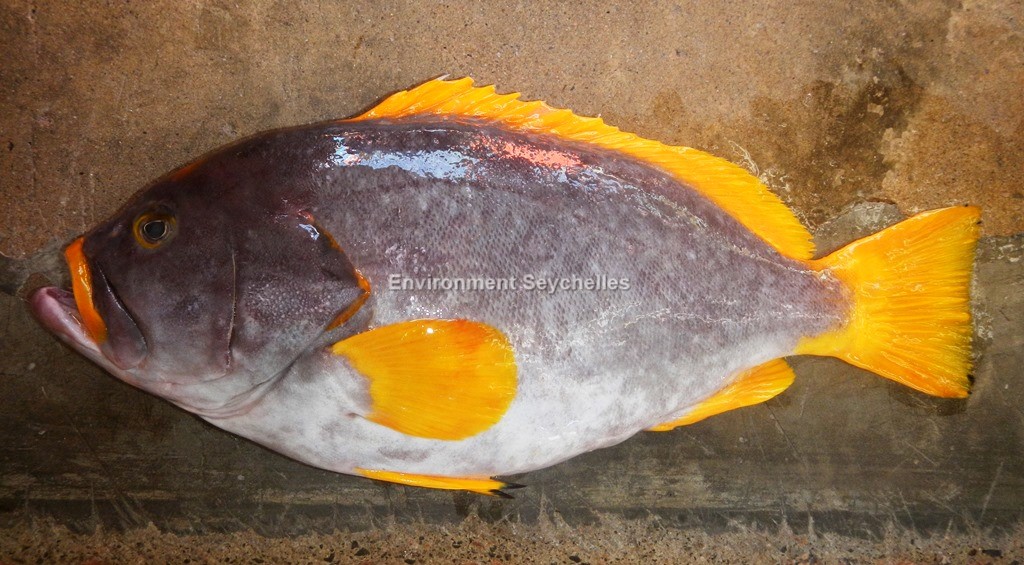Description:
Dorsal spines : 11; Dorsal rays: 16-17; Anal spines: 3; Anal rays: 8.
Large full-bodied grouper. Adults posterior nostrils 4-5 times larger than anterior nostrils. Posterior edge of maxilla reaches to or slightly past vertical at rear edge of
eye. 2-4 rows of teeth on midlateral part of lower jaw. Straight to slightly convex upper edge of operculum. Truncate to slightly emarginate caudal fin.
Colour. Juveniles light grey-blue body with bright yellow fins, lips and sometimes foreheads. Yellow colouration diminishes with growth, though many retain yellow tips to
their fins, may remain pale grey or body darkens to dark grayish, brown, slate blue or almost black. Some specimens in the grey to blue grey spectrum may be flecked with pale
blue. In some fish the corners of the caudal fin, the margin of the soft dorsal and anal fins and the tips of the pelvic fins are blackish.
Size:
Maturity: Lm unknown. Range 49-? cm. Max Length: at least 90.0 cm TL
(One specimen recorded in Seychelles, during a 2-year catch survey 2017/18, measured 96.5 cm TL – J. Nevill artisanal catch database).
Habitat and Ecology:
Reef associated species (depth 10-150 m) juveniles frequent shallower reefs and adults are found on deeper coral and rocky reefs. Feeds on a variety of fishes, crabs, shrimps,
spiny lobsters; squid and small octopodes. Solitary and possibly protogynous.
Fishery Status:
This species is not protected or subject to fishery regulations. It is caught in the handline and fish trap fishery, it is a common component of the catch and on occasion
numerous. It is the most common of the large groupers in the catch. Its size and value make it a species of economic significance to fishers.
Notes:
E. flavocaeruleus is similar in appearance and closely related to E. multinotatus and the two species are not distinguished by fishers sharing the same Creole name of
“Vyey Plat”. The only significant differences are their colour patterns. E multinotatus does not attain a deep blue hue and has numerous small brown spots on its lower head,
flanks and stomach. It is also typified by diffuse white blotches on the body as opposed to pale flecks. E. undulosus is also called "Vyey plat" and not distinguished by
fishers.
References:
Craig, M.T. et al. (2011). Groupers of the World - a field and market guide. NISC (Pty) Ltd, South Africa. ISBN: 978-1-920033-11-8
Froese, R. & D. Pauly. (Eds). (2018). FishBase. http://www.fishbase.se/summary/7345 (07/01/19).
Heemstra, P.C. & Randall, J.E. (1993). Groupers of the World. Vol. 16 FAO Species Catalogue. FAO Fisheries Synopsis No. 125, Volume 16. FIR/S125 Vol. 16
Nevill, J. (2013). A Species Identification Guide for Commonly Caught Fish in the Seychelles Near-Shore Artisanal Fishery. GOS/UNDP/GEF.
Samoilys, M. (2018). Epinephelus flavocaeruleus. The IUCN Red 2018: http://dx.doi.org/10.2305/IUCN.UK.2018-2.RLTS.T132726A100545091.en. (07/01/19).
Citation:
Nevill, J.E.G. (2019). Epinephelus flavocaeruleus, Blue-and-yellow grouper. Seychelles Seatizens. www.seatizens.sc. https://seatizens.sc/species/epinephelus-flavocaeruleus-lacepede-1802/ (edited 27/07/22).



